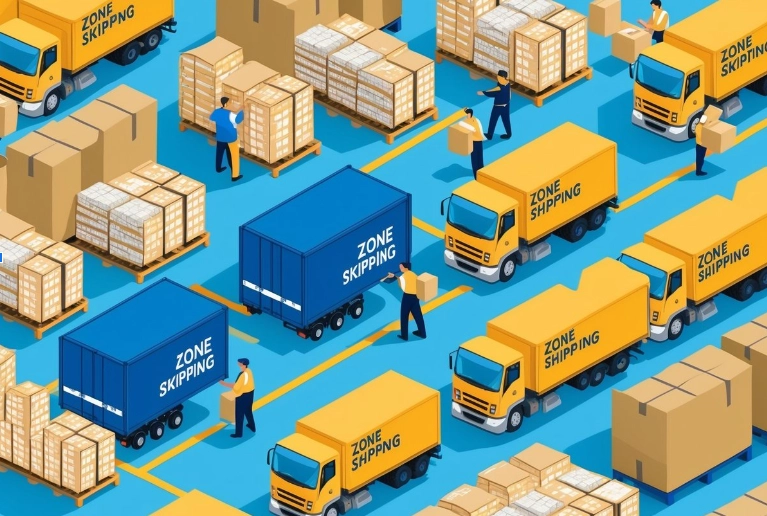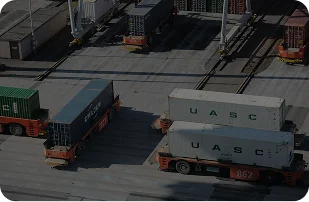Zone Skipping: A Smart Strategy to Cut Shipping Costs

Are your shipping costs eating into your profits? Many businesses don’t realize they’re paying premium rates for inefficient shipping routes. Zone skipping provides a solution that not only cuts costs but also speeds up delivery to your customers—a win-win strategy for businesses looking to optimize their logistics operations.
What is Zone Skipping?
Understanding zone skipping is essential for businesses looking to gain a competitive edge in logistics management and cost control.
Definition and Overview
Zone skipping is a logistics strategy where businesses consolidate multiple packages heading to the same general region and transport them together to a distribution center closer to the final destination. From there, packages enter the local delivery network, effectively “skipping” several zones in the carrier’s network.
Carrier networks like USPS, UPS, and FedEx divide the country into shipping zones based on distance from the origin point. With costs increasing as packages cross more zones, consolidating shipments allows businesses to bypass these intermediate zones by moving products in bulk to a hub closer to the final destinations.
Importance in E-commerce
For e-commerce businesses, zone skipping has become increasingly valuable as customer expectations for fast, affordable shipping continue to rise. According to industry data, businesses implementing these strategies can reduce shipping costs by 15-25% while improving delivery times by 1-2 days on average.
Companies that rely heavily on small parcel shipping find zone skipping particularly valuable, as it offers economies of scale that might otherwise only be available to larger operations with extensive carrier contracts.
How Does Zone Skipping Work?
The mechanics of zone skipping involve strategic consolidation and transportation planning to maximize efficiency and cost savings.
Process Overview
The zone skipping process follows several key steps:
- Package Consolidation: Businesses gather multiple packages heading to similar destinations.
- Bulk Transportation: These consolidated shipments travel together via truck, rail, or air freight to a distribution center closer to the final destinations.
- Local Sortation: At the destination hub, packages are sorted for local delivery.
- Last-Mile Delivery: Carriers complete the final delivery to customers through their local networks.
For example, a retailer with many West Coast customers might consolidate all those packages and ship them directly to a California distribution center, bypassing intermediate sorting facilities.
The economics work when the cost of bulk transportation plus local delivery fees is less than sending each package through the entire carrier network individually, typically requiring a minimum volume threshold of 300 orders monthly.
Key Components
Successful implementation relies on several critical elements:
- Data Analytics: Shipping volume analysis helps identify optimal consolidation opportunities and destination hubs. Software tools track package destinations to find patterns worth targeting.
- Transportation Partners: Strong relationships with freight carriers who can handle bulk shipments between major hubs are essential. These partnerships often include negotiated rates based on consistent volume.
- Distribution Network: Access to strategically located distribution centers allows businesses to position inventory closer to customers. These centers serve as consolidation and deconsolidation points.
- Inventory Management: Effective inventory forecasting ensures sufficient stock is available at each distribution point to meet customer demands.
Businesses implementing zone skipping should also explore the benefits of cross docking to further enhance efficiency by eliminating unnecessary storage and reducing handling time between inbound and outbound shipments.
Examples of Zone Skipping
This strategy works across various business models:
E-commerce Retail: A clothing retailer with a warehouse in Chicago might consolidate all packages heading to the Southwest, shipping them in bulk to a Phoenix distribution center for local delivery throughout Arizona, New Mexico, and Nevada.
Subscription Services: A meal kit company can maintain freshness by shipping consolidated pallets of boxes to regional distribution centers, where they enter local carrier networks for next-day delivery.
Manufacturing: A parts supplier can combine multiple small orders heading to automotive plants in the Southeast, shipping them as a single freight load to Atlanta for distribution throughout the region.
Benefits of Zone Skipping
Zone skipping offers multiple advantages that directly impact your bottom line and customer satisfaction levels.
Cost Reduction
The primary benefit is significant cost savings:
- Lower Per-Package Rates: Consolidating shipments gives businesses access to bulk shipping rates that are substantially lower than individual package rates. Savings typically range from 15-40%, depending on volume and distance.
- Reduced Zone Charges: Since packages enter the carrier network closer to their final destination, they cross fewer zones, directly reducing zone-based fees.
- Optimized Fuel Surcharges: Consolidated shipments require less fuel per package compared to individual routing, creating additional savings when fuel surcharges apply.
- Volume Discounts: Consistent large-volume shipments to specific regions can qualify for additional carrier discounts that aren’t available for individual packages.
For a mid-sized e-commerce business shipping consistently, these savings can translate to tens of thousands of dollars annually in reduced shipping costs.
Time Efficiency
Beyond cost savings, time efficiency creates competitive advantages:
- Faster Transit Times: By bypassing intermediate sorting facilities, packages reach customers 1-2 days faster on average. This improvement can transform standard shipping into an experience that rivals premium options.
- More Predictable Delivery: Fewer touchpoints in the shipping process mean fewer opportunities for delays, resulting in more consistent delivery times that businesses can reliably promise to customers.
- Extended Order Cutoff Times: With faster transit times, businesses can offer later daily order cutoffs while still meeting the same delivery timeframes.
These time efficiencies allow businesses to meet rising customer expectations without raising prices.
Risk Mitigation
Zone skipping also helps reduce various logistics risks:
- Fewer Touchpoints: With packages changing hands fewer times between origin and destination, there’s less opportunity for damage, loss, or misrouting. This directly translates to fewer customer service issues and replacement costs.
- Simplified Tracking: Consolidated shipments are easier to monitor until they reach the destination hub, giving businesses better visibility and control over their products in transit.
- Weather and Disruption Buffers: Using multiple regional distribution points creates flexibility during disruptions. If one region experiences delays, businesses can reroute through alternative hubs.
Companies implementing zone skipping report a 30% average reduction in damaged or lost packages, creating additional savings beyond the direct shipping cost reductions.
Is Zone Skipping Right for Your Business?
Not every business benefits equally from zone skipping strategies—understanding your shipping profile is crucial to determining its value for your operation.
Assessing Suitability
Consider these factors when evaluating zone skipping for your business:
- Shipping Volume: Zone skipping typically requires meeting minimum volume thresholds to a specific region to be cost-effective. Businesses shipping fewer orders may not realize sufficient savings.
- Geographic Distribution: Analyze your shipping data to identify concentrated delivery areas. This strategy works best when a significant percentage of your shipments go to specific regions rather than being evenly distributed nationwide.
- Product Characteristics: Consider your products’ weight, dimensions, and value. Higher-value items with moderate weight often benefit most from zone skipping due to the balance of shipping costs and protection benefits.
- Delivery Time Requirements: If your business competes on delivery speed, zone skipping can be particularly valuable in meeting customer expectations without premium shipping costs.
A thorough cost-benefit analysis should compare current shipping expenses against projected costs with zone skipping, including any additional handling or transportation requirements.
Implementation Steps
If zone skipping appears viable for your business, follow these steps for implementation:
- Data Analysis: Review 6-12 months of shipping data to identify volume patterns and potential consolidation opportunities. Focus on regions receiving the highest percentage of your shipments.
- Partner Selection: Research and select transportation partners for bulk shipping between your fulfillment center and destination hubs. Consider both cost and reliability in your evaluation.
- Distribution Network: Identify destination hubs in regions where you have significant delivery volume. These could be carrier facilities or third-party logistics providers like Innovative Warehouse Solutions that specialize in regional distribution with a focus on customer service excellence.
- Pilot Program: Start with a single high-volume region to test processes and confirm savings before expanding. This allows you to refine procedures with minimal risk.
- Technology Integration: Ensure your order management and shipping systems can properly route orders for zone skipping. This may require updates to your software integrations.
- Staff Training: Train fulfillment staff on new procedures for consolidating and preparing zone-skipped shipments, which differ from standard package handling.
For companies planning implementation during peak season, reviewing black friday logistics tips can provide valuable insights on managing high-volume consolidation without compromising delivery timelines during the most demanding retail period of the year.
Most businesses can implement a basic zone skipping program within 60-90 days, with ongoing optimization continuing as more data becomes available.
Customer Communication
Effective communication about shipping improvements offers marketing advantages:
- Clear Expectations: Update delivery time estimates on your website to reflect faster shipping times made possible through your improved logistics strategy.
- Shipping Options: Consider creating new shipping tiers that take advantage of these efficiencies, such as “Fast Standard Shipping” that promises delivery times previously only possible with expedited services.
- Marketing Advantage: Promote improved shipping speeds in marketing materials. Customers care about results—faster delivery at reasonable costs—not the logistics methods that make them possible.
- Tracking Updates: Ensure customers receive appropriate tracking information once packages enter the local delivery network from the regional hub.
By communicating these improvements effectively, businesses can turn logistics efficiency into a competitive advantage that builds customer loyalty.
Zone Skipping FAQs
What is zone pricing in logistics?
Zone pricing in logistics is a shipping rate structure based on distance from the origin to the destination. Carriers divide regions into zones, with costs increasing as the delivery zone gets farther from the shipping point.
What does zone mean when shipping?
In shipping, a zone refers to a geographic area used to determine delivery rates. Carriers assign zones based on the distance between the sender and recipient, affecting shipping costs and transit times.
How to calculate shipping zone?
Calculate a shipping zone by measuring the distance between the origin ZIP code and the destination ZIP code. Carriers use predefined zone maps to determine which zone a shipment falls into, influencing pricing and delivery speed.
What are zones in FedEx?
FedEx zones are geographic areas used to calculate shipping costs. Zones range from Zone 1 (local deliveries) to higher zones for long-distance shipments. The greater the zone number, the higher the shipping cost.
What is Zone 1 in logistics?
Zone 1 in logistics refers to the closest delivery area to the shipping origin. It typically covers local or nearby destinations, offering the fastest and most cost-effective shipping rates.
Conclusion
Zone skipping presents a strategic approach to shipping that can significantly reduce costs while improving delivery times. For businesses shipping sufficient volume to specific regions, the benefits extend beyond direct cost savings to include faster deliveries, reduced damage rates, and improved customer satisfaction.
As e-commerce continues to grow and customer expectations for fast, affordable shipping rise, efficient logistics strategies become increasingly important competitive differentiators. Businesses that analyze their shipping patterns and implement targeted zone skipping programs can create both operational efficiencies and marketing advantages.
At Innovative Warehouse Solutions, we prioritize transparent, customer-centric service that stands out in the 3PL industry. Our strategically located facilities and commitment to accuracy make us an ideal partner for implementing zone skipping strategies tailored to your specific business needs.
Ready to explore how zone skipping could benefit your business? Contact Innovative Warehouse Solutions for a consultation on how our fulfillment expertise and software solutions can help you implement cost-saving logistics strategies while providing the real-time, personalized support your business deserves.




